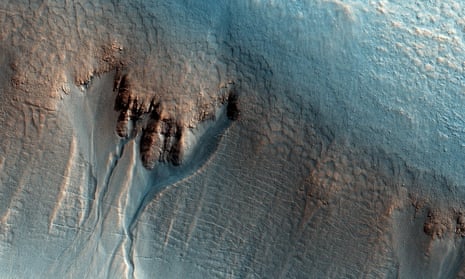Mars has always been, as cosmologist Carl Sagan wrote, a “mythic arena onto which we have projected our Earthly hopes and fears”. For the ancient Greeks, the red dot in the night sky was an aspect of Ares, god of war, who unleashed conflict when the balance was lost between Apollo – god of reason – and Dionysus, god of the irrational and chaos. This conflict between Apollonian reason and Dionysian chaos has been projected onto Mars ever since.
The canals that the astronomer Giovanni Schiaparelli claimed in 1877 to see on the surface of Mars were taken as evidence that, like newly industrialised nations of Europe, “Martians” might be reasoning, civilised creatures. Later observations proved the canals to be illusions, but the idea of a Martian civilisation took hold, and became the mainstay of stories about the red planet.
If these Martians shared our Apollonian fascination with technology, perhaps they also shared our warlike and violent nature? This simple fear provides the premise for HG Wells’s War of the Worlds, in which a Martian army invades the home counties. Victorians were deeply fearful that a technologically superior enemy might do to them just what they had done in so many other nations. The novel’s most famous passage could almost be a description of how the British empire might appear from the other side of the globe.
Yet across the gulf of space, minds that are to our minds as ours are to those of the beasts that perish, intellects vast and cool and unsympathetic, regarded this earth with envious eyes, and slowly and surely drew their plans against us.
A Princess of Mars by Edgar Rice Burroughs, only a decade later, reclaimed the red planet as a setting for the most Dionysian of fantasy stories. Transported from late 19th-century America, John Carter is thrown into a series of epic quests to rescue the princess Dejah Thoris. To writers and readers caught in the mass industrialisation of the early 1900s, Mars as “Barsoom” provided a blank canvas on which their imaginations could run riot, and Burroughs’ works began a genre of “planetary romances” including the popular Flash Gordon comics and the excellent Martian stories of Leigh Brackett.
It was into this field of pulp adventure that Ray Bradbury’s Martian Chronicles exploded in 1950. American astronauts arrive on Mars to find an alien society that is oddly reminiscent of the suburban world of postwar America. Bradbury’s Mars is a mirror of an America on the threshold of materialism, hypnotised by the Apollonian promise of science, and its gifts of labour-saving devices and automobiles. But hiding within the American dream is the bubbling chaos of Dionysian irrationality. Science, as Bradbury argues, “is no more than an investigation of a miracle we can never explain, and art is an interpretation of that miracle.”
Nasa’s Viking missions to Mars in the late 1970s transformed our vision of the planet. As the first photographic images from the planet’s surface were decoded, it seemed that Mars was nothing but a big ball of rock – geologically interesting, but biologically sterile. Part of the thrill of reading Wells, Burroughs or Bradbury – that their imaginings might resemble the reality of the red planet – was forever ended. The only life that would ever play out its story on the surface Mars, would come from Earth.
Kim Stanley Robinson’s Red Mars, Green Mars and Blue Mars are, arguably, the greatest of all Martian stories. Over a period of two centuries, humankind colonises, terraforms, and ultimately transforms Mars into the future of our species, while old Earth spirals down into social and environmental collapse. The allegory at the heart of Robinson’s superbly depicted drama is one of balance, in which science and religion, reason and imagination, the Apollonian and the Dionysian, are no longer in conflict. Robinson’s is a holistic vision, reflecting the emergent ecological awareness of the 1990s. For all its scientific deftness, it is deeply sceptical of unbalanced scientific progress.
They were so ignorant! Young men and women, educated very carefully to be apolitical, to be technicians who thought they disliked politics, making them putty in the hands of their rulers, just like always. It was appalling how stupid they were, really, and he could not help lashing into them.
Kim Stanley Robinson’s words from Red Mars could almost be a pre-emptive shot across the bows of the audience cheering for Mark Watney in The Martian. The message of both Robinson’s and Andy Weir’s novels can be neatly encapsulated to the three-word internet meme: “Yeah Science, Bitch.” As Watney says after he finds himself marooned on Mars, he is going to have to “science the shit” out of the problems between him and survival.
The Martian is a hymn to the Apollonian values of reason, in which enough science can overcome all problems. If our stories of Mars reflect our earthly hopes and fears, then The Martian plays to an audience that is already pinning all its hopes on science and technology. Just as The Martian falls flat because it never really investigates the psychological, interior experience of life marooned on an alien world, so maybe today we actually need a little less “yeah science, bitch”, and a little more Dionysian dreaming and chaos. Perhaps the discovery of flowing water on the Martian surface, raising the prospect of microbial life, might yet inject a little Dionysian chaos into Weir’s dead planet.

Comments (…)
Sign in or create your Guardian account to join the discussion